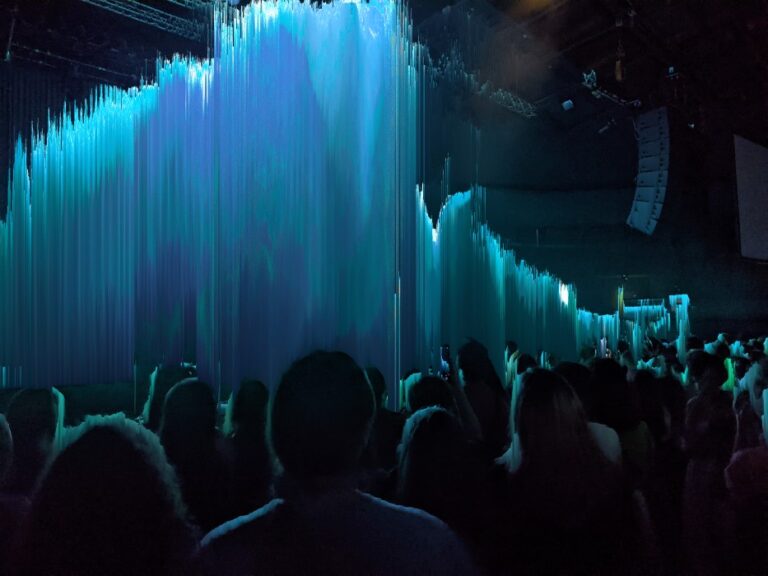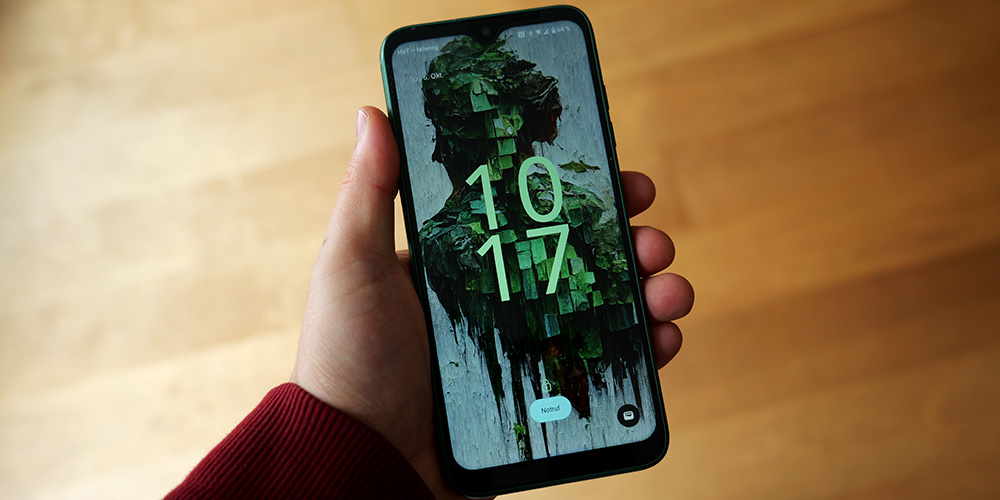Feelings, Thoughts and Rules for the Future of AI

When I first saw “Green girl” I was scrolling through r/pixelsorting, and I really liked it. And most of the time I don’t upvote or like stuff online. They don’t need my data, is what I’m thinking. But I also wanna show my appreciation for this piece of art I discovered, so I upvote it and even save it on my phone. I keep looking at it and naturally try and figure out how it was made. Normally, pixel sorting involves having an algorithm sort the pixels by some defined criteria. You could use a threshold to start and end a sort, so to leave some structure of the underlying image. The stuff in between gets sorted by each pixel’s brightness and voilà you have a pixel sort. You can apply this idea to different values then brightness, but the principle stays the same.

But this image of “Green girl” doesn’t seem like a simple pixel sort, it also doesn’t really strike me as some sort of composite image with pixel sorting elements, it actually hardly looks like a pixel sort at all, more like a rendering inspired by the concept of pixel sorting. So I try to dig a little deeper and look at the page of the artist u/kavurmija on Reddit, where I find a clue to some AI tool being used. That was July 2022 and AI art was already getting going, and I didn’t really know how to feel about it. In fact, when I found out, the first feeling I had was almost a form of betrayal. It certainly was a pretty strong reaction. But still… I really liked that piece, but was it now wrong for me to like it? At that point I had already saved it and just went on with my day. But it certainly stayed with me, not only the artwork, but the strong reaction I had to it being made with AI. And this experience being 2 years old at this point clearly means I’m still thinking about it and so are a lot of other people. It’s not that the dust has settled, it’s more like the dust is still in the air, just in a different place. But my feelings have cleared up at least a little bit and I had more chances to work with these tools and figure out what I’m comfortable with and how they work.
First of all, this experience made me realize that part of what I like about art is all the bits and pieces left in the artwork of the people creating it. Every artist/creator leaves a little bit of themselves in their work, and I think it’s almost impossible to not do so. But the process by which text to image generators work, looses out on parts of the thought processes that a human creator (potentially) can have while working on something. The small decisions that happen in the creative process are being outsourced to some algorithms. And that can seem a little bleak, but that doesn’t mean you have to put in no intention and no effort. Generative AI tools, when used in a creative workflow that draws from a multitude of techniques, can be a great aid to the intention of the artist. In that case, I feel like, the human element can be strong enough to constitute it being called an original creation. Of course, “strong enough” is a very fuzzy line, but we handle fuzzy lines in copyright law quite a bit when talking about Fair Use. And as I am trying to set up a kind of framework on how I am going to use these tools, let’s go with this thought as rule 1.
Rule 1: Human intention can drive a piece enough as to constitute an original creation.
If you wanna use these tools with a clear conscience, one of the main problems is the way they get created. Because as far as I can tell, most are trained on images that are clearly copyrighted and no consent on the side of the artists/rights holders was given for the images to be used in this way. Sometimes the wording used is it was “trained with images available on the open web”, which yeah duh, the biggest database is the “open web”. But there are a lot of things on the “open web” you don’t have the right to use, especially in a commercial way. The web is build on collaboration, remixing, legal gray areas and weird symbiotic relationships as is, but systematically scraping and exploiting the work of a whole lot of artists really puts a strain on these (more or less concrete) rules. And I think the most problematic case is artist imitation, where you can essentially copy the style of an artist with very little effort. That is obviously wrong if you want to celebrate the artist, and obviously even worse if you try to sell that art. In that case, the intention (which I think is a key element in all of this) is malicious to some degree.
Rule 2: I will never impersonate an artist’s style to make it my own, maybe to reference or explore it but never to maliciously exploit or gain from it.
What I also definitely want is some sort of label if AI tools are being used. When I first saw “Green girl” I was trying to figure it out because it seemed to matter to me how exactly it was made. In some ways, it made me feel like it was less personal and interesting, so it really impacted what I thought about it. I don’t think it matters as much to me at this point in time, but there are a lot of people that are sensitive to the subject, and in these cases it seems just more considerate to disclose some information about the tools that were used. How exactly that should look like is going to depend on the use and the context. Some tools that don’t really impact the creative decisions of a work are, in my opinion, less important to disclose. As an example, a tool that does a very specific task a normal algorithm could already do, but now it’s better with ✨ AI ✨ doesn’t necessitate a huge made with AI label, and in my work I’ll honestly probably forget to label stuff like that. But these tools most of the time are less problematic in the way they were created anyway. More concretely, some tools for noise removal in audio recordings existed before everything was called “AI” but they do a better job now that they are trained using machine learning, if that actually makes it artificial intelligence would be a discussion for another day. But any generative AI, to me, constitutes a label of some sort.
Rule 3: I will always label generative AI use.
So when using generative AI, I want to be very conscious of how I’m using it. Firstly, that includes that my intention is the driving force behind the work, secondly that I’m not using a specific style to basically rip off some other artist. When I made my first generative AI project “cell” I used a technique that really felt like it enabled me to control the creation process in a meaningful way. Typically, image generators use text prompts to guide the image generation, which definitely infuses some intention into the work, but also leaves quite a bit of room for the model to make decisions on its own. But there are plenty of things you can do to take more control over that process, especially in the realm of the open source models and tools created around Stable Diffusion. I have yet to use ComfyUI which is the champion in that field at the moment but used Stable Diffusion with the automatic1111 interface for “cell”. And the game changer for me was the image to image function that you can use to stylize and change an original image. That means that the scene composition is almost completely in your control, and the defining features of the structure are yours to imagine. What you use as an original image is up to you, in the case of “cell” I used a scene in Unreal Engine 5 to capture a video, but camera recordings work as well. The pass with Stable Diffusion then stylizes the video according to a text prompt and for “cell” also added a lot of detail. I used a model specifically for an oil painterly style and added a bit of sound design. This let me feel like I was in the driver seat of the creation process and definitely made it feel like an original creation.
The generative AI in “cell” is basically used as a kind of “filter” on steroids, and the style used is (I feel) generic enough as to not encroach on anybody’s creative territory. I haven’t written the algorithms I use for pixel sorting, but I still consider them original work. The way I incorporated generative AI in this project feels very much the same. And while these models are still pretty clearly trained with copyrighted material, in a way artists didn’t agree to – and these artists should be compensated fairly for that – in my eyes you can use them in a non-malicious way. To enhance your creative process, to speed up techniques that in the past would have been reserved for much larger teams, and to brainstorm or modify your own creations. Cheap art and copycats have been around a long time, and it definitely is easier and faster to create those things with these tools. But there will always be a lot of art that is expressive, special, beautiful and personal, with a magnetism “cheap and easy” rarely captures. Art will prevail, as it always has.
Rule 4: There are styles and ways to use these tools that are “unspecific” enough, as to not harm any other artist in the process, especially if rule 1 applies.
These rules and my thought processes behind them are now laid out and will be transparently displayed on this site (with an explicit placement in the footer) as an “AI Use Disclosure”. And I would encourage others to do the same. I came up with this kind of disclosure in the making of this website as to have a somewhat clear statement on why and how I am going to be using AI. But of course I will continue to evaluate how the AI space is going to progress and what effect it is going to have on the creative industry. Which just means I might change my mind in the future and want to have an open discussion about it. But I hope my thought process on this topic sheds a bit of light on how we can think about creative work in the coming years.
While these rules are somewhat subjective, there are some ideas that are good starting points for more universial applications. And since there is going to be a need for new guidelines and laws in the future, we should start the discussion early, and try to think about the core values of art and creation. I for my part found “intention” as the core idea of my creative thinking and no AI can take that away from me. But as we already struggle with aging copyright laws, core ideas like that may be the way foreward.
